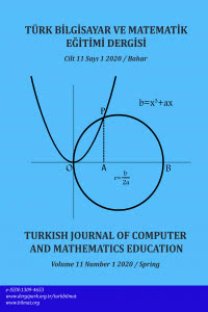Deneysel Doğrulamadan Formel İspata Uzanan Süreçte Dinamik Geometri Yazılımlarının Potansiyeli
-
The Potential of Dynamic Geometry Software in Bridging the Link Between Experimental Verification and Formal Proof
-,
___
- Bruckheimer, M., & Arcavi, A. (2001). A Herrick among mathematicians or dynamic geometry as an aid to proof. International Journal of Computers for Mathematical Learning, 6(1), 113-126.
- Christou, C., Mousoulides, N., Pittalis, M., & Pitta-Pantazi, D. (2004). Proofs through exploration in dynamic geometry environments. International Journal of Science and Mathematics Education, 2(3), 339-352.
- Cuoco, A. A., & Goldenberg, E. P. (1997). Dynamic geometry as a bridge from Euclidean geometry to analysis. In J. King & D. Schattschneider (Eds.) Geometry turned on: Dynamic software in learning, teaching and research (pp. 33-46). MAA NOTES
- Furinghetti, F., & Paola, D. (2003). To produce conjectures and to prove them within a dynamic geometry environment: A case study. International Group for the Psychology of Mathematics Education, 2, 397-404.
- Guven, B. (2008). Using dynamic geometry software to gain insight into a proof. International Journal of Computers for Mathematical Learning, 13(3), 251-262.
- Hanna, G. (2000). Proof, explanation and exploration: An overview. Educational studies in mathematics, 44(1-2), 5-23.
- Hoyles, C. & Jones, K. (1998). Proof in dynamic geometry contexts. In C. Mammana & V. Villani (Eds.) Perspectives on the Teaching of Geometry for the 21st Century (pp.121-128). London, Springer.
- Jones, K. (2000). Providing a foundation for deductive reasoning: Students' interpretations when using dynamic geometry software and their evolving mathematical explanations. Educational studies in mathematics, 44(1), 55-85.
- Mariotti, M. A. (2006). Proof and proving in mathematics education. In A. Gutierrez & P. Boero (Eds.) Handbook of Research on the Psychology of Mathematics Education (pp. 173-204). Rotterdam: Sense Publishers
- MEB (2013). Ortaöğretim Matematik Dersi Öğretim Programı. Ankara
- Mogetta, C., Olivero, F., & Jones, K. (1999). Providing the motivation to prove in a dynamic geometry environment. Proceedings of the British society for research into learning mathematics, 19(2), 91-96.
- Polya, G. (1957). How to solve it: A new aspect of mathematical thought (2nd ed.). Princeton, NJ: Princeton University Press
- Straesser, R. (2002). Cabri-Geometre: Does dynamic geometry software (DGS) change geometry and its teaching and learning?. International Journal of Computers for Mathematical Learning, 6(3), 319-333.
- Yayın Aralığı: 3
- Başlangıç: 2009
- Yayıncı: Türkbilmat Eğitim Hizmetleri
Dinamik Geometri Yazılımı Kullanımının Geometri Başarısına Etkisi: Bir Meta-Analiz Çalışması
Berna Cantürk Günhan, Hatice Açan
Bahar Dinçer, Esra Akarsu, Süha Yılmaz
Ortaokul Matematik Öğretmenlerinin Ders İmecesi Hakkındaki Görüşleri
Farklı Öğretim Yöntemleri ve Sınıf Seviyesine Göre Öğretmen Adaylarının TPAB Analizi
İlköğretim Matematik Dersi Sınav Sorularının MATH Taksonomisine Göre Analizi
Berna Aygün, Demet Baran Bulut, Ali İpek
Türkiye ve Almanya’nın Ortaokul Matematik Öğretmeni Yetiştirme Programlarının Karşılaştırması
Problem Çözmede Zihnin Matematiksel Alışkanlıkları
Samet Korkmaz, Sefa Dündar, Hakan Yaman
Matematik Öğretmeni Adaylarının Türev Kavramıyla İlgili Yaptıkları Hatalar
Matematik Öğretmenlerinin GeoGebra ile Hazırlanan Çalışma Yaprakları Üzerine Görüşleri
